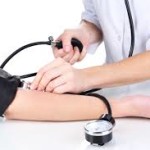 Then once every 3 – 6 months your doctor should order an A1C test to give you and the doctor an overall view of how well the glucose has been controlled in the past three months. The A1C is also called a glycosylated hemoglobin test. The American Diabetes Association recommends that this test is done twice a year for people who are well controlled and more often when blood sugars are not well controlled, if diabetics have other illness (illness affects control of the blood sugar) or when the treatment of the condition is changed. (4)
Then once every 3 – 6 months your doctor should order an A1C test to give you and the doctor an overall view of how well the glucose has been controlled in the past three months. The A1C is also called a glycosylated hemoglobin test. The American Diabetes Association recommends that this test is done twice a year for people who are well controlled and more often when blood sugars are not well controlled, if diabetics have other illness (illness affects control of the blood sugar) or when the treatment of the condition is changed. (4)
A serum creatinine test is recommended once a year. This is a simple blood test that helps the doctor to determine how well your kidneys are performing. Serum creatinine is excreted through the kidneys and is a by-product of muscle metabolism. So if your kidneys aren’t working well they won’t excrete as much of the chemical.
A urine microalbumin test also evaluates the health of your kidneys by measuring the amount of protein that leaks through the kidneys into the urine. If your kidneys become damaged the waste products that kidneys normally filter remain in your blood and the protein that normally is in your blood leaks to your kidneys. The test is usually done on a one time fresh urine sample, although your physician may do a quantitative 24 hour study and ask you to collect 24 hours worth of urine.
 The last diabetes test that is commonly done are lipid tests to evaluate your low density lipoproteins (LDL) and high density lipoproteins (HDL). Diabetes and heart disease are linked because of the damage that is done to the body from the Diabetes and because those with Diabetes have a higher risk of developing heart disease.
The last diabetes test that is commonly done are lipid tests to evaluate your low density lipoproteins (LDL) and high density lipoproteins (HDL). Diabetes and heart disease are linked because of the damage that is done to the body from the Diabetes and because those with Diabetes have a higher risk of developing heart disease.
Doctors use the results of these tests to help determine how much vessel damage may be happening. The American Heart Association and the American Diabetes Association recommend that these tests are done once a year, more often if you are on lipid lowering drugs.
Diabetes tests have improved the way in which Diabetes is monitored and treated. Now, with vigilant monitoring and treatment, patients have a lower risk of high blood pressure, stroke, heart disease and peripheral vascular disease then they once had even 10 years ago.
References:
(1) National Diabetes Information Clearinghouse:
Diagnosis of diabetes
http://diabetes.niddk.nih.gov/dm/pubs/diagnosis/
(2) MayoClinic.com: Diabetes
http://www.mayoclinic.com/health/diabetes/ds01121/dsection=tests-and-diagnosis
(3) MedlinePlus: Glucose Tolerance Test
http://www.nlm.nih.gov/medlineplus/ency/article/003466.htm
(4) American Diabetes Association: Living with Diabetes
http://www.diabetes.org/living-with-diabetes/treatment-and-care/blood-glucose-control/a1c/
| Advertisement | |
 |
|


Leave a Reply